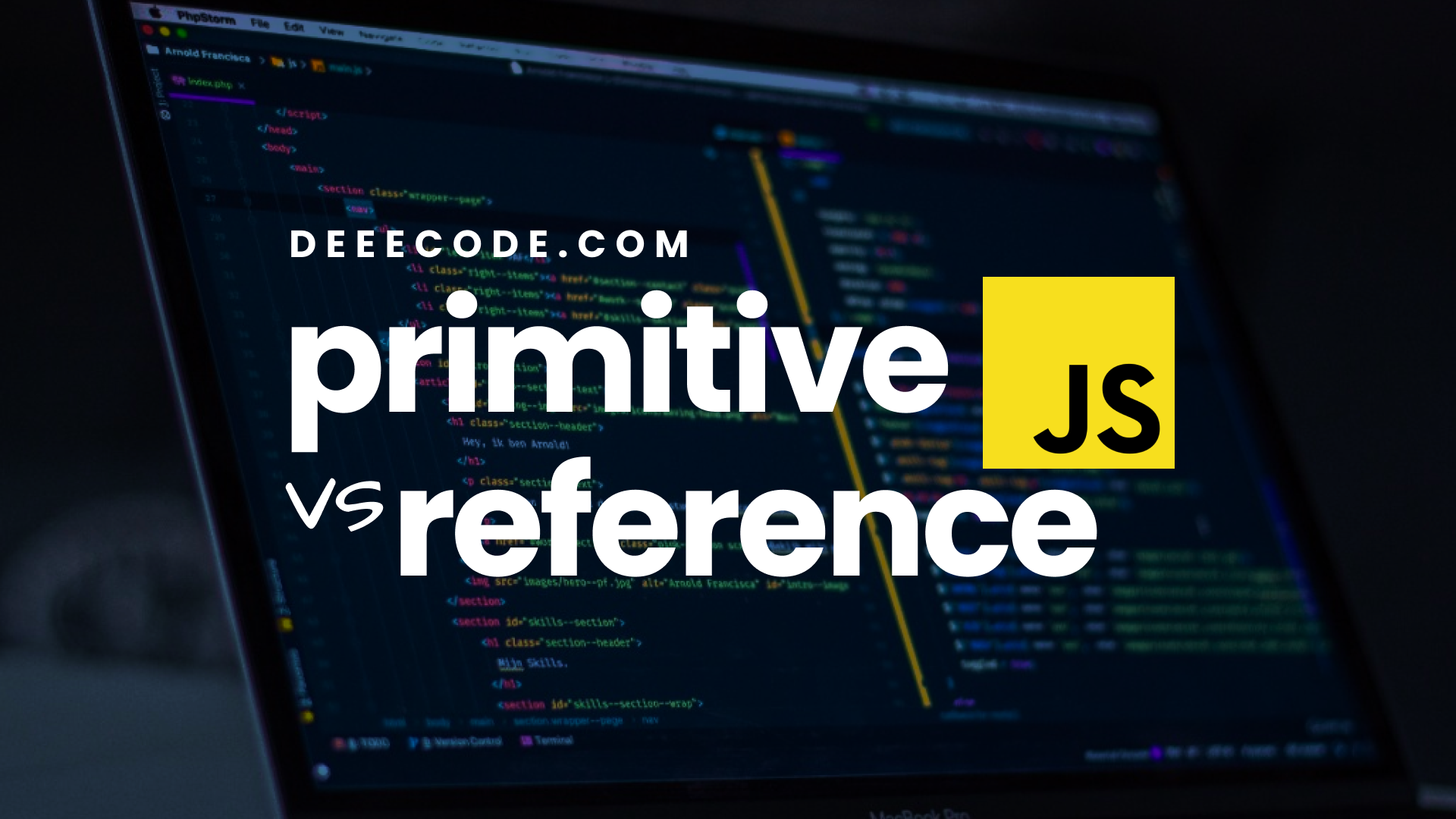
Primitive vs Reference Values in JavaScript
I also have a video version of this topic you can check out!
Primitive Values
In JavaScript, you have primitive values which are of the types string, number, boolean, null, undefined, symbol, and BigInt. These values are referred to as atomic or static values. For examples:
let name = "Dillion"let age = 60let isRaining = true
Here we have three variables, each with primitive values:
- name has "Dillion"
- age has 60
- isRaining has true
These values are static (fixed) which makes their size known during compile time. When JavaScript is storing such data in memory, it knows how much space is needed. Such static data are stored in the stack memory of a JavaScript engine. The process is called static memory allocation. In the stack, you have the variable name and the value it holds:
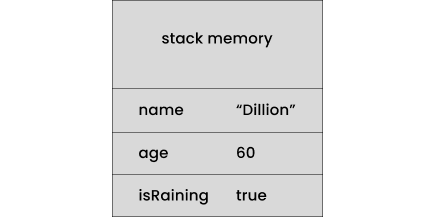
Reference values
In JavaScript, objects are referred to as reference values. This type of data can be likened to "a group of multiple values". Arrays, objects, and functions fall under the objects category. They are called reference values because the values are stored in the heap memory, and the respective "static" reference is stored on the stack. For example:
const array = [1, 2, 3]const obj = {name: "Dillion"}function print() {console.log("hello")}
In JavaScript's memory:

As you can see illustrated above, the object's data is stored "somewhere" in memory, and the address of its location is stored as a reference in the stack.
Object values are stored in the heap memory because they are not fixed. JavaScript doesn't know how much memory such values would need because they are dynamic; dynamic in the sense that the data can change after initialization. For example, you can modify arrays or objects after the initial declaration:
const array = [1, 2, 3]const obj = { name: "Dillion" }// later onarray.push(5, 6)obj.age = 10
As you see here, the array can have extra values and the object can have extra properties (or modified properties) later on. Here's what it would look like in the JavaScript engine:
Initially:
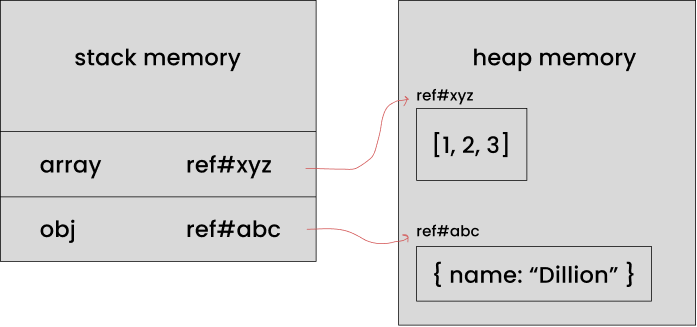
Later on:
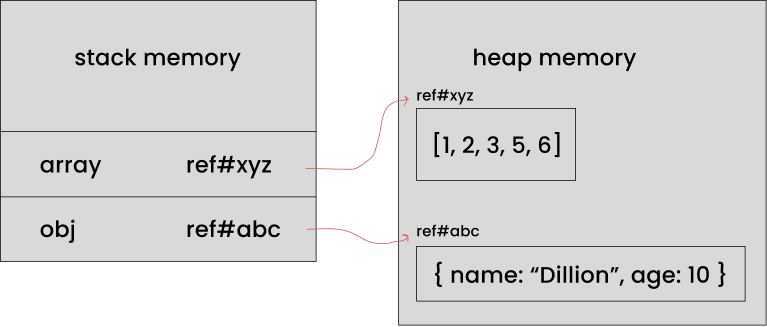
Notice that the references do not change. Only the data changes.
Modifying Object Values
When you modify an object, you are not modifying the reference, but actually modifying the object's data. Here's what I mean.
Take a look at this example:
let name = "Dillion"let name2 = name
Here, we declared a variable called name and assigned it a value of "Dillion". Then we declared a variable called name2 and assigned it name. What we have done here is assign the value that name holds in memory to name2. Now the stack would look like this:
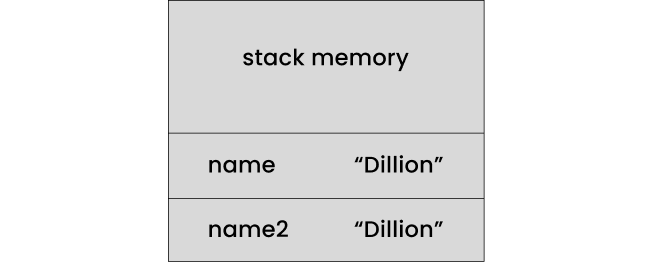
If I should change name2 to something else, it will not affect name:
name2 = "Deeecode"console.log(name2)// Deeecodeconsole.log(name)// Dillion
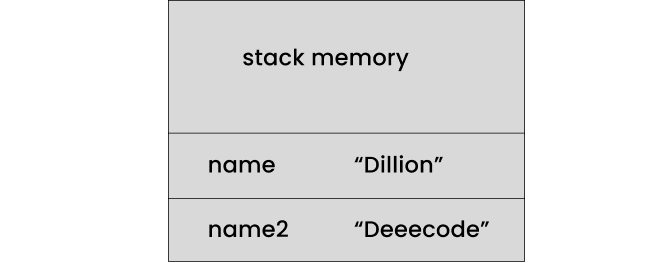
Here, we changed the value of name2 to "Deeecode", but as you can see in the logs, name still holds the value of "Dillion". Assigning name to name2 as we saw previously name2 = name, does not mean that name2 and name are the same thing. What we did was "assign the value of name to name2". They remain different variables.
But in the case of reference values, things are a bit different.
We saw earlier that reference values are stored in the heap, and the reference is stored in the stack. Let's say we assign one array variable to another. For example:
let array = [1, 2, 3]let array2 = array
What do you think happens here?
Perhaps you think [1, 2, 3] in array is assigned to array2. No!
Remember, the value that array holds in the stack (since it is of the object category) is a reference and not the object data. So what happens here is that the reference that array holds will be assigned to array2 like this:
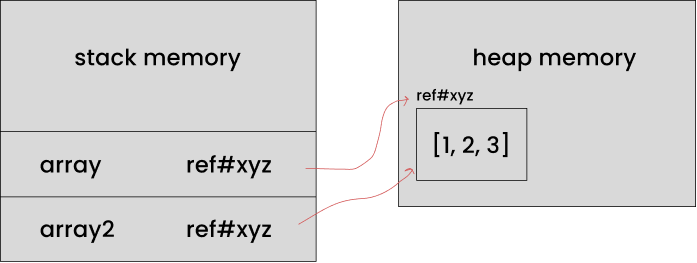
So, array and array2 are now holding the same reference. Let's say you modify array2:
array2.push(4)console.log(array2)// [1, 2, 3, 4]
What do you think happens to array?
Remember again I said that, "when you modify an object, you are modifying the object's data and not the reference". In this case, it means array2 will modify the data stored in the reference it holds:
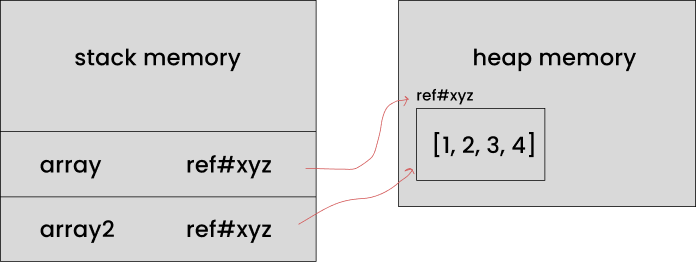
Since array has the same reference, it would have the updated object's data:
console.log(array2)// [1, 2, 3, 4]console.log(array)// [1, 2, 3, 4]
array and array2 point to the same address in memory, so when you modify array, array2 will be affected and when you modify array2, array would be affected.
Comparing Primitive and Reference Values
Another thing to look at with primitive and reference values is comparisons. Comparison behaviors differ between both of them.
For example:
const array = [1, 2, 3]const array2 = [1, 2, 3]const isEqual = array === array2console.log(isEqual)// false
Can you guess:
array not equal to array2 even when they hold the data [1, 2, 3]?If you selected the third option: "they hold different memory references in the stack", you are correct. Here's why.
For the code example:
const array = [1, 2, 3]const array2 = [1, 2, 3]
Here's what happens on the stack and heap:
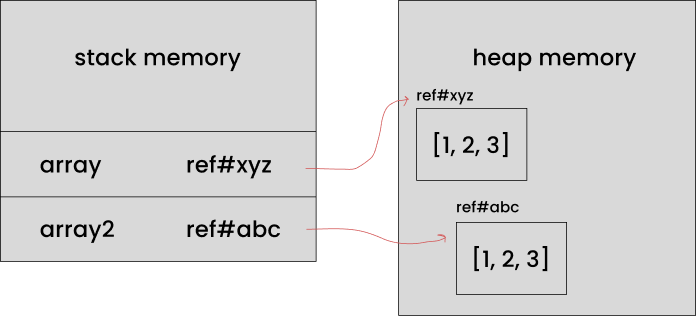
As you can see, even though both values are the same, they are stored in different memory locations in the heap. Remember that object values are dynamic, which means array can be modified later, and array2 may not be modified. So JavaScript cannot put both values in the same location.
The references in the heap are then assigned to the variable names in the stack. So when you do array === array2, you're actually not comparing [1, 2, 3] and [1, 2, 3]. What you're actually comparing is the references, which in the diagram above are ref#xyz and ref#abc (for example purposes).
Wrap Up
Primitive and Reference values are one of the fundamental concepts of JavaScript. Understanding this would save you a lot of problems and would deepen your knowledge of JavaScript.
I hope you found this helpful, if so, please: